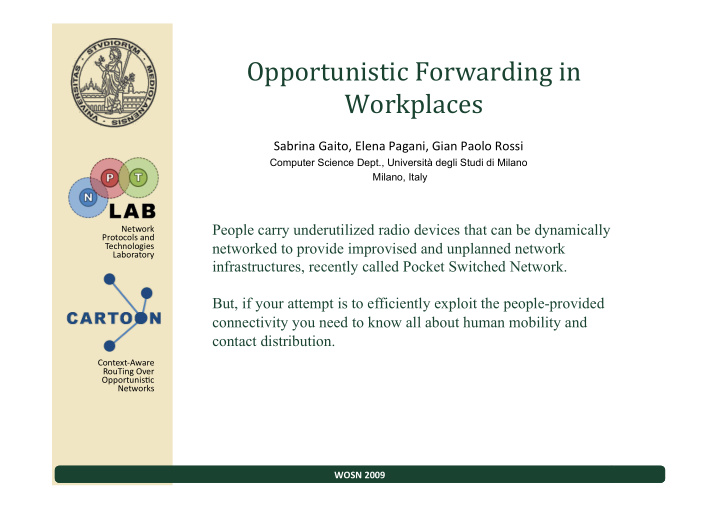



Opportunistic Forwarding in Workplaces Sabrina Gaito, Elena Pagani, Gian Paolo Rossi Computer Science Dept., Università degli Studi di Milano Milano, Italy People carry underutilized radio devices that can be dynamically Network Protocols and Technologies networked to provide improvised and unplanned network Laboratory infrastructures, recently called Pocket Switched Network. But, if your attempt is to efficiently exploit the people-provided connectivity you need to know all about human mobility and contact distribution. Context‐Aware RouTing Over OpportunisDc Networks 18 aprile 2008 WOSN 2009
Goals of the work • most of the research focuses on sparse settings • but: Future Internet with billions of mobile devices forming a pervasive infrastructure • our focus: dense settings (workplaces, campuses …) • why? • informal (w.r.t. institutional IT platforms); friendly; easy-to-use; inexpensive; unmanned • … as emerged from our survey • trend: SMSs Twitter, Mobile Messaging • problems: • impact of social relations on both contacts and forwarding • capability of satisfying users’ needs 2 17 Aug. 2009 WOSN 2009
Pocket Mobility Trace Recorder • device characteristics fine grained contact monitoring • short radio range • long lasting batteries (3 weeks) • • PMTR carriers’ characteristics profiled people • 44 PMTRs for 15 working days • • “terrain” characteristics 3.5 Km offices and other classrooms classrooms 200 x 100 m. 3 floors 3 17 Aug. 2009 WOSN 2009
Characterization of the environment • 11895 contacts PMTR MIT % contacts within a day 80% 47% mean inter‐contact Dme 11 h 49’ 4 days 3h median inter‐contact Dme 41’ 29” 16 h mean intra‐contact Dme 8’ 41” 57’ median intra‐contact Dme 48” 32’ 4 17 Aug. 2009 WOSN 2009
Day‐by‐day behavior inter-contact time intra-contact time 5 17 Aug. 2009 WOSN 2009
Optimal‐latency routing • impact of short contacts ( “one-shot” diffusion) • low median inter-contact another opportunity soon • large impact on coverage • misleading latency: computed on different sets all contacts >5’ min latency 1 h 29’ 2h 50’ mean latency 2 h 33’h 4h 44’ broadcast max latency 5 h 2’ 1d 25’ mean # hops 5 6 coverage 100% 44% mean latency 40’ 25” 57’ 44” unicast mean # hops 2.81 2.97 6 17 Aug. 2009 WOSN 2009
Social relations: map (whole experiment) • impact of geography students strangers few short friends few long familiar many short strangers community many long people in the no contact same corridor 7 17 Aug. 2009 WOSN 2009
Social forwarding: environment • encounters: #contacts between two nodes in a certain relation • relays: #pairs of nodes in a certain relation (from map) class #encounters #relays community 311 68 fam.strangers 1012 196 strangers 392 324 friends 133 90 8 17 Aug. 2009 WOSN 2009
Social forwarding: results • P = Σ #uses / Σ #encounters normalized P = P / #people present • use: % relays of various classes comm fam.str. strang. friends P (all) 0.3119 0.3883 0.9949 0.9850 use (all) 10% 39% 39% 12% use (> 1’) 15% 41% 27% 17% use (> 2’) 20% 38% 26% 16% use (> 5’) 21% 32% 18% 29% mean intra 2314 188 120 2983 mean inter 75 40 23 3040 9 17 Aug. 2009 WOSN 2009
Social forwarding: results 10 17 Aug. 2009 WOSN 2009
Conclusions • short contacts • of prominent importance for message forwarding • beaconing capability of detecting them • trade-off: detection accuracy vs. energy saving • social forwarding • local/distributed characterization of friendship levels • use of friendship info for relay selection • different policy for relay selection depending on relation between source and destination? http://nptlab.dico.unimi.it 11 17 Aug. 2009 WOSN 2009
Recommend
More recommend